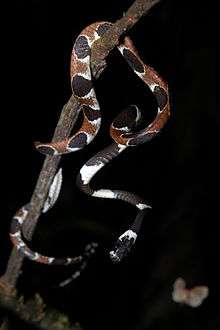Dipsas
Dipsas is a genus of nonvenomous New World snakes in the subfamily Dipsadinae of the family Colubridae. The genus Sibynomorphus has been moved here.
| Dipsas | |
|---|---|
 | |
| Dipsas catesbyi in Ecuador. | |
| Scientific classification | |
| Kingdom: | Animalia |
| Phylum: | Chordata |
| Class: | Reptilia |
| Order: | Squamata |
| Suborder: | Serpentes |
| Family: | Colubridae |
| Subfamily: | Dipsadinae |
| Genus: | Dipsas Laurenti, 1768 |
Geographic range
Species in the genus Dipsas are found from southern Mexico through Central America and South America, as far as Argentina and Paraguay.[1][2]
Description
Dipsas species are slender, small to medium-sized snakes, often no longer than 60 cm (24 in), and rarely longer than 100 cm (39 in). Coloration and color pattern may vary, but often consist of black and brown, frequently with alternating rings separated by white.
Behavior and diet
Species in the genus Dipsas are mostly arboreal snakes that mainly feed on land snails and slugs.
Species
The following species are recognized as being valid.[4]
- Dipsas albifrons (Sauvage, 1884)
- Dipsas alternans (Fischer, 1885)
- Dipsas andiana (Boulenger, 1896)
- Dipsas articulata (Cope, 1868)
- Dipsas baliomelas Harvey, 2008
- Dipsas bicolor (Günther, 1895)
- Dipsas bobridgelyi Arteaga et. al., 2018
- Dipsas brevifacies (Cope, 1866)
- Dipsas bucephala (Shaw, 1802)
- Dipsas catesbyi (Sentzen, 1796)
- Dipsas chaparensis Reynolds & Foster, 1992
- Dipsas cisticeps (Boettger, 1885)
- Dipsas copei (Günther, 1872)
- Dipsas elegans (Boulenger, 1896)
- Dipsas ellipsifera (Boulenger, 1898)
- Dipsas gaigeae (Oliver, 1937)
- Dipsas georgejetti Arteaga et. al., 2018
- Dipsas gracilis (Boulenger, 1902)
- Dipsas incerta (Jan, 1863)
- Dipsas indica Laurenti, 1768
- Dipsas jamespetersi Arteaga et al., 2018
- Dipsas klebbai Arteaga et. al., 2018
- Dipsas latifrontalis (Boulenger, 1905)
- Dipsas lavillai Scrocchi, Porto & Rey, 1993
- Dipsas maxillaris (F. Werner, 1910)
- Dipsas mikanii (Schlegel, 1837)
- Dipsas neivai Amaral, 1926
- Dipsas neuwiedi (Ihering, 1911)
- Dipsas nicholsi (Dunn, 1933)
- Dipsas oligozonata Orcés & Almendáriz, 1989
- Dipsas oneilli Rossman & Thomas, 1979
- Dipsas oreas (Cope, 1868)
- Dipsas oswaldobaezi Arteaga et. al., 2018
- Dipsas pakaraima MacCulloch & Lathrop, 2004
- Dipsas palmeri (Boulenger, 1912)
- Dipsas pavonina Schlegel, 1837
- Dipsas peruana (Boettger, 1898)
- Dipsas praeornata (F. Werner, 1909)
- Dipsas pratti (Boulenger, 1897)
- Dipsas sanctijoannis (Boulenger, 1911)
- Dipsas sazimai Fernandes, Marques & Argôlo, 2010[5]
- Dipsas schunkii (Boulenger, 1908)
- Dipsas temporalis (F. Werner, 1909)
- Dipsas tenuissima Taylor, 1954
- Dipsas trinitatis Parker, 1926
- Dipsas turgida (Cope, 1868)
- Dipsas vagrans (Dunn, 1923)
- Dipsas vagus (Jan, 1863)
- Dipsas variegata (A.M.C. Duméril, Bibron & A.H.A. Duméril, 1854)
- Dipsas ventrimaculatus (Boulenger, 1885)
- Dipsas vermiculata J.A. Peters, 1960
- Dipsas viguieri (Bocourt, 1884)
- Dipsas williamsi Carillo de Espinoza, 1974
Nota bene: A binomial authority in parentheses indicates that the species was originally described in a genus other than Dipsas.
References
- De Lima AC, Da Costa Prudente AL (2009). "Morphological variation and systematics of Dipsas catesbyi (Sentzen, 1796) and Dipsas pavonina Schlegel, 1837 (Serpentes: Dipsadinae)". Zootaxa 2203: 31-48. Abstract & excerpt
- Cadle, John E. (2005). "Systematics of snakes of the Dipsas oreas complex (Colubridae: Dipsadinae) in western Ecuador and Peru, with revalidation of D. elegans (Boulenger) and D. ellipsifera (Boulenger)". Bulletin of the Museum of Comparative Zoology. 158 (3): 67–136. doi:10.3099/0027-4100(2005)158[67:SOSOTD]2.0.CO;2. Retrieved 2011-02-11.
- "Dipsas ". Integrated Taxonomic Information System. Retrieved 10 February 2011.
- Genus Dipsas at The Reptile Database. www.reptile-database.org.
- Fernandes DS, Marques OAV, Argôlo AJS (2010). "A new species of Dipsas Laurenti from the Atlantic Forest of Brazil (Serpentes: Dipsadidae)". Zootaxa 2691: 57–66. Preview
Further reading
- Freiberg MA (1982). Snakes of South America. Hong Kong: T.F.H. Publications. 189 pp. ISBN 0-87666-912-7. (Genus Dipsas, pp. 93–94).
- Laurenti JN (1768). Specimen medicum, exhibens synopsin reptilium emendatam cum experimentis circa venena et antidota reptilium austriacorum. Vienna: "Joan. Thom. Nob. de Trattnern". 214 pp. + Plates I-V. (Dipsas, new genus, pp. 89–90). (in Latin).
External links
| Wikispecies has information related to Dipsas |
| Wikimedia Commons has media related to Dipsas. |